
The analysis of flow around a cyclist’s head is shown, with a focus on the helmet and glasses, as performed by Aerotherm using CD-adapco STAR-CCM+ CFD software. Image courtesy Aerotherm Computational Dynamics/CD-adapco.
April 1, 2016
 The analysis of flow around a cyclist’s head is shown, with a focus on the helmet and glasses, as performed by Aerotherm using CD-adapco STAR-CCM+ CFD software. Image courtesy Aerotherm Computational Dynamics/CD-adapco.
The analysis of flow around a cyclist’s head is shown, with a focus on the helmet and glasses, as performed by Aerotherm using CD-adapco STAR-CCM+ CFD software. Image courtesy Aerotherm Computational Dynamics/CD-adapco.So you get that simulation is good, but have you got it? Caution is understandable, but what’s stopping you, and many others in small- and medium-sized businesses (SMBs), from simulating designs well before building them? Although the concept is definitely spreading industry-wide (check out the DE publication, The Design Engineer’s High-Performance Computing Handbook for savvy examples) perhaps you just haven’t found the right tool for your budget, timeframe and experience.
DE asked a wide range of analysis-software providers what they’re doing to address the barriers (perceived or actual) of cost, compatibility, accessibility, ease-of-use and more. You’ll find offerings for individual parts or complete assemblies, single-physics or multiphysics, cloud options, flexible licensing and open sources. The possibilities should have you taking a second look at adding more analysis to your workflow.
Starting With What You Know
Familiarity breeds comfort, not contempt. Because most engineers still begin the design process with a CAD model, it’s no wonder that adding simulation directly inside a favorite CAD program is an appealing solution. PTC and SOLIDWORKS have spent decades adding mechanical analysis functions to their geometry-creation packages and platforms. CAD-embedded tools can offer perhaps some of the power of comparable functions found in dedicated analyst software, at much less cost.
Jose Coronado, product manager at PTC, knows that SMBs need a quick and reliable simulation engine that doesn’t require a Ph.D. in finite element analysis (FEA) modeling to make it work. He notes that PTC Creo Simulate, a general purpose simulation tool, will cover many of the cases that an SMB engineer typically encounters; it handles thermal and structural analysis and simplifies the process using automated meshing. Creo Advanced Simulation Extension software adds nonlinear and buckling capabilities that are still manageable by the non-expert. And PTC offers embedded tutorials, reseller support and a complete distance-learning training course for added ease-of-use.
SOLIDWORKS product portfolio manager, Nicolas Tillet, says his company is always looking to lower barriers to entry via ease of use. SOLIDWORKS Simulation software, fully embedded in SOLIDWORKS 3D CAD, includes structural, fluid-flow, thermal, vibration and plastics-injection simulation for both parts and assemblies. Depending on the version used, engineers can investigate a range of materials and behaviors. “SOLIDWORKS Xpress offers free SOLIDWORKS Simulation ‘light,’ for users to play with basic stress analysis (on individual parts). We also offer free tutorials and forums,” Tillet says.More recently, Autodesk has taken on the challenge of adding simulation functions to its CAD products. Greg Fallon, vice president of Simulation Products at Autodesk, cites a number of influences, from the need for SMBs to demonstrate a competitive edge (without prohibitive startup and maintenance costs) to the fact that those users have varying skill sets and are geographically spread throughout the country and around the globe.
Designers and engineers can address these points with Autodesk Fusion 360, the company’s project to revolutionize simulation access and capabilities. As a cloud-based system, Fusion 360 lets user access full functionality for as little as $25/month, and there’s a special free one-year license for startups for in-depth tryouts. Supported analysis types include linear static stress, modal frequency and thermal/thermal stress. User-written apps are encouraged and often discussed on the Fusion GitHub Website. For a taste of things to come, check out Autodesk Labs’ Project Arro, termed “a technology preview for an emerging simulation product called SimStudio” at Autodesk Beta.
It’s refreshing to see new and lesser-known analysis-software companies also working to ease the perceived pain of doing mechanical simulation and fluid dynamics analyses. SIMSOLID co-founder and CEO Ken Welch says the needs of SMBs are exactly what his company targets. “There are two fundamental roadblocks for simulation usage in SMBs: price and complexity of working with design geometry,” he observes. “Cloud-based access, pay-as-you-go is a good start, and we do low monthly subscription rates.” But beyond this, his company’s tagline — “simulation reinvented” — points to a fundamental difference in SIMSOLID’s philosophy. “We accept the design geometry as is, without the need to modify it for the meshing process,” he explains. (For details of how SIMSOLID simplifies structural, modal and thermal/thermal stress analyses, see Welch’s write-up at SIMSOLID.)
That type of flexibility and ease of use are also philosophies guiding CONSELF. The company is based in Italy, but its computational fluid design (CFD) platform, CONSELF Cloud CFD 2.0, is available anywhere via a Web browser. It has plans designed for independent contractors, SMBs and enterprises. Interested engineers can give it a try with 20 free simulation credits per month.Another relevant cloud-based simulation platform is SimScale, from the company of the same name. Through a standard Web browser, users upload a CAD model, choose and set up an analysis and analyze the results. The website states that SimScale is “an ecosystem in which simulation functionality, content and people are brought together in one place” with both free and low-cost monthly subscriptions. Simulation processes are founded on CalculiX (for structural work) and OpenFOAM (for fluid analysis) software. (Check out SimScale for some thought-provoking user insights on SimScale.)
Speaking of OpenFOAM (open source) software, Chris Greenshields, co-director at CFD Direct (and one of the original co-founders of OpenFOAM), sees this software used by consultancy companies across a broad range of engineering, and often for simulating processes rather than products. (Think of predicting how a valve in a chemical plant might clog and how to improve its design or usage.) Greenshields notes that providing the software at no cost lowers a major barrier to entry for CFD (computational fluid dynamics) simulation, avoiding recurring fees and per-seat licensing. His company provides services and training courses to customers to help them build their CFD competence while continuing to develop, maintain and release OpenFOAM.
Lastly, a designer-targeted simulation product that may not have surfaced on your radar is Midas NFX, first released in 2009 by Midas Information Technology. These solutions address contact, nonlinear, fluid-structural, CFD, heat transfer and other behaviors. Users say that Midas NFX presents a very intuitive interface, with extensive online guidance in the form of interactive tutorials and FEA analysis guides. The company offers a 15-day trial license, with special support plan pricing available for small businesses and consultancies.
SMB Outreach From Classic Sources
CAD-integrated simulation can work in the other direction, too. Autodesk offers Nastran In-CAD, which can even work in SOLIDWORKS, along with higher-level simulation packages addressing mechanical, injection-molding, CFD, and composites specialties. Companies such as Mentor Graphics (with embedded and tightly-integrated CAD options), COMSOL (with its LiveLink packages) and Siemens PLM (with third-party solvers linked to NX Advanced FEM) have created seamless operations between standard CAD systems and advanced simulation.
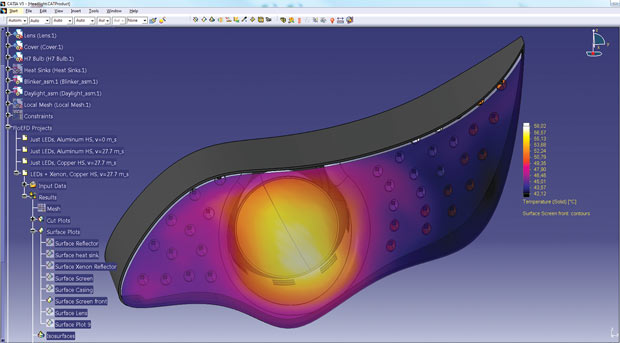 FloEFD flow/thermal analysis software from Mentor Graphics allows designers to perform CFD analyses within their own CAD environment. Image courtesy of Mentor Graphics.
FloEFD flow/thermal analysis software from Mentor Graphics allows designers to perform CFD analyses within their own CAD environment. Image courtesy of Mentor Graphics.Quick design iterations are what Mentor Graphics sees as crucial for SMBs. With the company’s options for its FloEFD built into Siemens NX, PTC Creo and Dassault Systèmes CATIA V5, engineers can run simulations directly on CAD models without leaving their preferred environment. A version can also integrate with Autodesk Inventor and Siemens PLM Solid Edge.
“Our software developers and scientists didn’t spend their time creating a scientific tool that requires only scientists to use it; instead, they created an engineering tool that has the know-how of CFD science built into its core,” says Boris Marovic, industry manager for Mentor Graphics. If desired, FloEFD can be customized for applications such as combustion or hypersonic flow, but, notes Marovic, keeping these specialties as add-ons keeps the price down. FloEFD is not cloud-based but is available through a browser for a 30-day evaluation.
Valerio Marra, technical marketing manager at COMSOL, also understands that small businesses need to get the most value from their investments; his company offers several ways to do so. “One option, a six-month single-user license,” Marra explains, “would include a COMSOL Multiphysics product combination suitable for mechanical engineering and CAD import. The user would have instant access to customer support and training opportunities.” Secondly, COMSOL offers tools in its LiveLink product line that links 3D designs created in various CAD, mathematical and spreadsheet programs directly to COMSOL Multiphysics, supporting synchronous, two-way design development. Lastly, a COMSOL Certified Consultant can build an app (using COMSOL Application Builder software), which can then run at an SMB on a low-cost COMSOL server license.
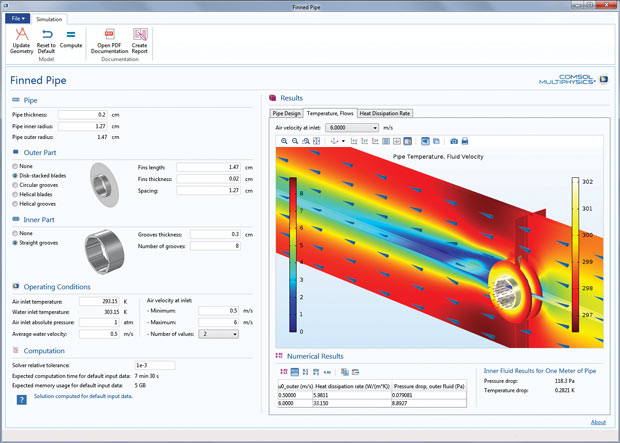 Finned Pipe custom application created by an analysis expert with COMSOL Multiphysics’ Application Builder. Image courtesy of COMSOL.
Finned Pipe custom application created by an analysis expert with COMSOL Multiphysics’ Application Builder. Image courtesy of COMSOL.Siemens PLM has already put years of effort into broadening its user base beyond the Ph.D.-level analyst. Because SMB users might be doing structural analysis one week and thermal analysis another, the company has partnered with the Rescale platform to offer on-demand access to NX Simulation products. Within the software, wizards and simplified interfaces called roles guide non-experts from design changes through simulation in a seamless flow with just a few clicks. Ravi Shankar, director of Simulation Product Marketing at Siemens PLM, describes two additional aids: Experts can employ the NX Open tool to capture and publish simulation processes for designers, while new users can get comfortable with NX CAE products by connecting with the vibrant online NX community.
These well-established simulation companies aren’t alone in reaching out to SMBs. Simone Bonino, vice president of Marketing for Altair HyperWorks, says his company makes sure prospective users understand what simulation means to them and why they are pursuing it. “It is important to find the subset of simulation that will be manageable (i.e., meet their ROI goals) without becoming overwhelming or impossible to implement,” Bonino explains. “It’s about making them see that a few weeks of inconvenience can mean months and months of increased throughput and improved designs. With a small team, everyone has to be flexible. The right tools can allow them to handle the design phase then switch right into analysis with ease.” Several of Altair’s cost-effective entry options come via the line of HyperWorks Unlimited virtual and physical simulation appliances.
If you don’t generally think of ANSYS in the same sentence as small business, you may want to think again. The company’s cloud-based AIM product, introduced quietly in early 2015, is all about democratizing simulation for broader use. Christine Wolfe, ANSYS lead product manager for Multiphysics, says, “The products that SMBs are designing are themselves becoming more complex — nobody makes a simple product anymore — [so] users need a way to get up to speed fast on both single- or multi-physics analysis. We understand that they may not be using simulation day in and day out. Non-experts need a tool that can guide them but still give an accurate answer.” Users get a free two-hour trial, including four guided sample analyses, at ANSYS.com/TryItNowAIM where they can set-up runs automatically without any sign-up.
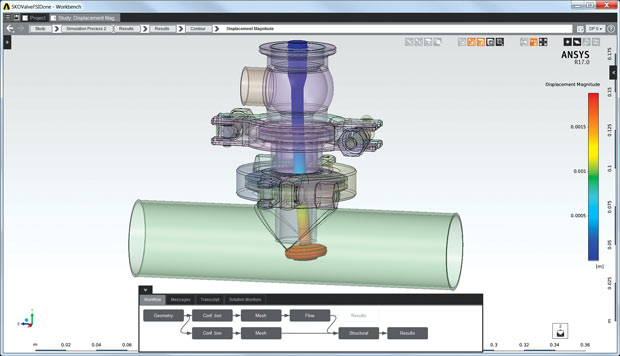 The ANSYS AIM user-friendly interface for setting up and performing a multiphysics (mechanical and fluid) analysis on a valve assembly is pictured. Image courtesy of ANSYS.
The ANSYS AIM user-friendly interface for setting up and performing a multiphysics (mechanical and fluid) analysis on a valve assembly is pictured. Image courtesy of ANSYS.Don’t overlook one of the grandfathers of simulation software companies: MSC Software. Leslie Bodnar, vice president of Global Marketing, says smaller firms can’t always afford the necessary investment in software and a full-time analyst, so one solution is to have an outside source perform modeling, meshing or the full simulation. “A service project is much less risky,” says Bodnar, “and is a cost-effective way to get started down the path of integrating virtual test methods into the design process.”
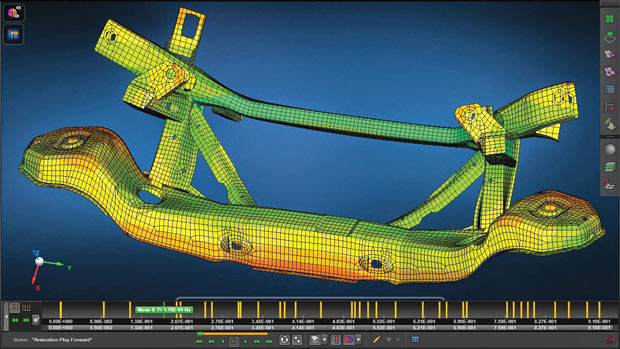 MSC Apex, part of the MSC One Start Edition from MSC Software, helps users evaluate design behavior through modal analysis. Image courtesy of MSC Software.
MSC Apex, part of the MSC One Start Edition from MSC Software, helps users evaluate design behavior through modal analysis. Image courtesy of MSC Software.Another MSC Software approach for SMBs is the MSC One Start Edition, a new token-based, annual subscription licensing system. “The tokens give the (SMB) access to a range of physics and applications including structural analysis, multibody dynamics, nonlinear and multi-physics, and our new CAE platform, MSC Apex, for approximately $10,000,” says Bodnar.
Fluid Dynamics for Non-Experts
While many designers have become comfortable doing mechanical simulations, the realm of CFD can still seem out of reach. However, this perception is changing for both simple and complex applications as CFD companies of all sizes tackle ease-of-use, education, pricing and accessibility (see “Expanding the Search for CFD Solutions.”)
For years, CD-adapco (currently being acquired by Siemens PLM Software) has helped companies access the power of CFD analyses. The company was a pioneer in the licensing concepts of Power-Sessions and Power-on-Demand. David Vaughn vice president of Worldwide Marketing at CD-adapco, says these options take away any penalty for doing more simulations. “Such flexible licensing, combined with improved hardware and easier-to-use software, make it possible for one person to do CAD, meshing and simulation within a small business,” notes Vaughn. “It’s a power tool, so we provide all the attachments and fittings to use it for specific cases; we have some vertical applications such as for mixing [plus] a Java API (application programming interface) and a portal called Macro Hut for sharing scripted macros. But probably our biggest contribution is our support, where we have a dedicated support engineer for even the smallest customer.”
As a small business, Flow Science can understand the complexities and difficulties of bringing a highly technical product to market and competing with bigger players. Its FLOW-3D package supports multiphysics CFD processes coupled with thermal and structural analyses. “Our aim is to give our customers a highly accurate simulation tool that ultimately improves their bottom line,” says Amir Isfahani, vice president of Sales and Business Development at Flow Science. “We offer consulting services, which is a great way for smaller companies to explore CFD, or an affordable short-term license. Our trial license offers new customers the opportunity to explore the software under the tutelage of experienced hands.” Flow Science also offers batch processing for added speed, plus custom scripting for its FlowSight visualization tool.
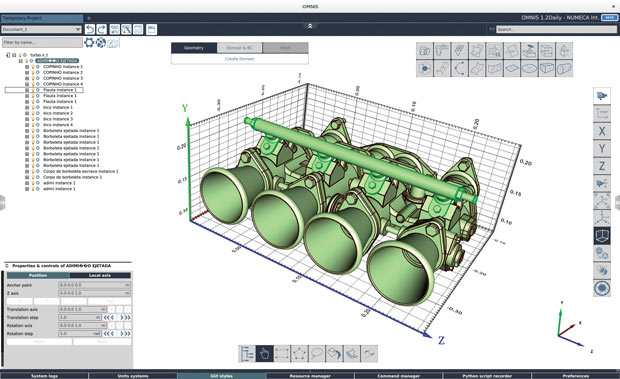 An example of OMNIS, the new-generation graphical user interface (GUI) from NUMECA for its FINE family of CFD and FSI software products. The GUI is designed to be extremely simple, with no menu, automatic grid generation on less-than-perfect geometry, and parallel batch and graphics operations even on large datasets. Image courtesy of NUMECA.
An example of OMNIS, the new-generation graphical user interface (GUI) from NUMECA for its FINE family of CFD and FSI software products. The GUI is designed to be extremely simple, with no menu, automatic grid generation on less-than-perfect geometry, and parallel batch and graphics operations even on large datasets. Image courtesy of NUMECA.Supporting small- and medium-sized enterprises with reliable, cost-effective CFD and multiphysics simulations is the primary goal of NUMECA International. This Belgium-based company offers worldwide support for a family of products that includes AutoMesh, CFView, FINE/Open with OpenLabs, FINE/Turbo, FINE/Acoustics and FINE/FSI-OOFELIE (the latter for fluid-structure interaction simulations).
Marc Tombroff, NUMECA general manager, says his company’s new OMNIS user environment addresses the need for a user-friendly interface with features such as automatic creation of high-quality grids on “dirty” CAD files, a fast mesh preview option, a simple no-menu GUI (graphical user interface), close links to CAD systems and fast simulation return time on coarse grids. Tombroff adds: “We are amazed to see how many SMBs start using our NUMECA cloud solution based on UberCloud containers.” NUMECA has also recently launched an app called WindTunnel CFD for real-time CFD on tablets.
Symscape and Hanley Innovations are two more CFD software vendors that understand the needs of small businesses. Symscape’s Caedium is a great place for the SMB to start fluid analysis with a focus on internal and external flows, with or without heat transfer. Richard Smith, principal engineer at Symscape, says users can download the basic version of Caedium at no cost; it functions as a viewer for Caedium files and provides a feel for Caedium’s capabilities. The software’s interface is very contemporary, based on drag-and-drop and multi-level undo/redo functions that are easy to navigate. To step up to performing CFD simulations, users download various targeted Caedium add-ons; all are available as free 30-day trials; purchase prices are listed on site and one-on-one support is available.
For some users, a more application-specific program is just what they need. For example, designers seeking guidance on lift, drag and aerodynamic moments should look to Hanley Innovations. Among its software products, the company’s Stallion 3D software analyzes 3D CAD designs (e.g., planes, cars, sailboats), while its MultiElement Airfoils package helps users evaluate the behavior of 2D airfoil shapes. As owner Patrick Hanley notes: “You don’t necessarily need the power of a thousand cores to get CFD answers.” Both programs use automatic grid generation and can produce results in just hours on laptop computers.
More Info
Subscribe to our FREE magazine, FREE email newsletters or both!
About the Author
Pamela Waterman worked as Digital Engineering’s contributing editor for two decades. Contact her via .(JavaScript must be enabled to view this email address).
Follow DE





